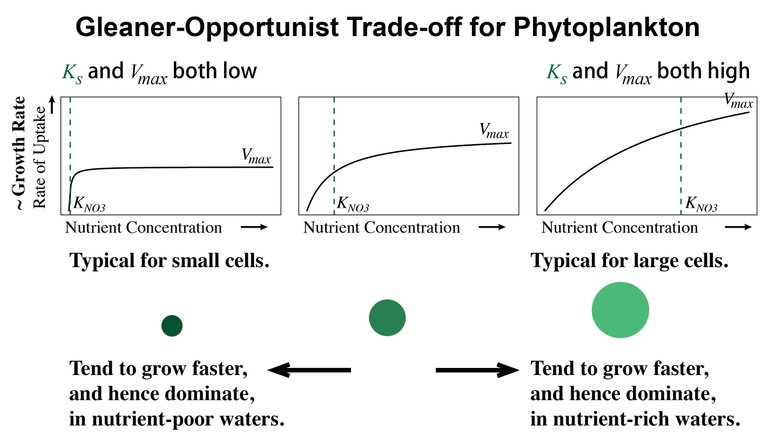Mechanism of Resilience in Communities with Different Size Distributions: Underlying mechanism of biodiversity-productivity relationships Clarified
In a new study entitled Phytoplankton size-diversity mediates an emergent trade-off in ecosystem functioning for rare versus frequent disturbances, just published in the journal Scientific Reports, yours truly and two co-authors have used a theoretical model of phytoplankton communities to provide a new explanation for the wide variability observed in the relationship between diversity and productivity in various published studies.

In environments with less frequent disturbances, phytoplankton communities with less diversity tend to be slightly more productive (left). On the contrary, when disturbances are more frequent, more diverse communities tend to be more productive, up to a point.
Diversity-Productivity Relationships
Biodiversity is known to be important for sustaining the productivity of ecosystems and for maintaining their resilience. However, different relationships have been observed between biodiversity and productivity, and the underlying mechanisms have remained uncertain. We developed a continuous trait-distribution model for a phytoplankton community of gleaners (those species that do well when nutrients are scarce) competing with opportunists (species that do well when nutrients are plentiful) and subjected the model community to differing frequencies of disturbance, in order to examine diversity-productivity relationships.
The Assumed Trade-Off
The simple model is based on a well-known trade-off involving the traits typical of different sized phytoplankton, which tend to dominate in different environments. For more details, you can see my previous post about Trade-offs.

The Emergent Trade-Off
Here we consider productivity at the community level. A community is a collection of species sharing a common resource base.
The assumed trade-off, which applies at the level of the individual cell or species, together with the fact that more diverse communities can change their size composition faster, gives rise to an emergent trade-off between diversity and productivity of the entire community. The relationship between size-diversity within the community and overall community productivity therefore depends on the frequency of disturbance experienced by the community. Here we imposed disturbances in a way that mimics the mixing events typical of the near surface ocean (and lakes as well). Such mixing events can be driven by eddies of water swirling around, storms, wind, or strong ocean currents.

Results for the Productivity-Diversity relationship for the short-term (7d) average. Short-term Adaptive Capacity (AC) is quantified by the specific growth rate for the whole phytoplankton community (vertical axis, left side) averaged over the 7 day period after the beginning of disturbances. The horizontal axis (bottom) shows the size diversity index, h. The different lines show results for different frequencies of disturbance (shown by arrows on the right side), which were considered as drastic mixing events in the ocean, causing a sudden decrease in the phytoplankton biomass and a corresponding increase in nutrients. A high frequency of 1 d-1 means one disturbance per day, and a low frequency of 1/7 d-1 means one disturbance per week. Productivity tends to increase most strongly from low to intermediate diversity under frequent disturbance. However, under rare (low frequency) disturbance, more diverse communities are less productive.
Selection Effect Enhances Temporal Complementarity
In the figure above, the white squares to the left show the productivity of the single most productive size for each disturbance frequency. The fact that diverse communities are in many cases more productive (sometimes much more) than the single most productive size, is called ‘transgressive overyielding’. It arises because of ‘temporal complementarity’ among species (sizes) as the size distribution shifts during the 7 day period examined. Furthermore, we show for first time that the ‘selection effect’, that is the tendency of the fittest species (here the fittest size) to come to dominate the community, can enhance temporal complementarity.
This study revealed that:
More diverse communities tend to be more productive in the short-term under frequent disturbance, because diversity enhances adaptive capacity, which is the ability to recover from sudden changes in environmental conditions. That is because the more diverse communities more quickly shift their size distributions and therefore take better advantage of changing conditions.
On the other hand, less diverse communities tend to be more productive over long periods with infrequent disturbance, because then the most productive community is composed of (nearly) identical species having just the right traits (inherent characteristics) for the nearly constant environmental conditions.
More diversity does not in all cases enhance productivity, because the diversity-productivity relationship changes with the frequency of disturbance.
Why do we care?
Besides an interest in basic ecology, specifically in understanding the emergent properties of ecosystems, the productivity of phytoplankton communities is of interest to anyone who cares about the overall productivity of marine ecosystems, including fisheries.

Phytoplankton, which constitute the base of the food chain, sustain the productivity of marine and freshwater ecosystems.
What are the Practical Implications?
This theoretical study suggests that if limited resources (time, funding, staff) are to be allocated efficiently for the preservation of biodiversity, it would make sense to focus efforts on areas with moderate to high variability (relatively frequent disturbance) and areas in which such variability is expected to increase. This is because the benefits of biodiversity tend to be greatest in such areas, compared relatively calm environments.
S. Lan Smith
Kamakura, Japan
October 18, 2016
Nice article man, and congrats on the nature publication!
Thanks!
Have you thought about writing in Japanese as well? SteemIt Japan was created to help Japanese posts.
Thanks!
I have thought about it, but I did not know about Steemit Japan. I'll check it out.
We have just prepared a press release, in Japanese and in English, about this article. So, I could post that.
Excellent!
There are significant Russian and Chinese communities on here. I want to see it take off in Japan, too.
Glad to see you blogging again! I was missing your texts!
And congratulations for this publication!
Thanks! I was busy travelling for work, and with work in general.